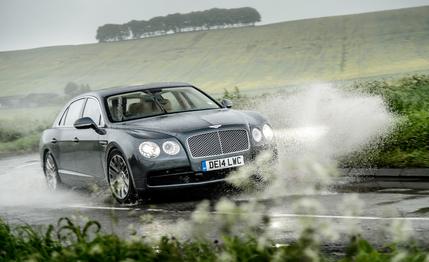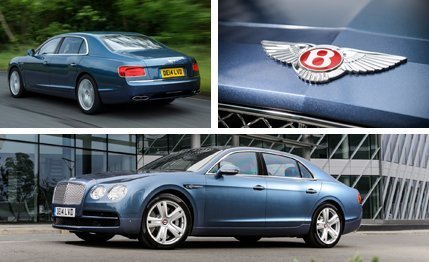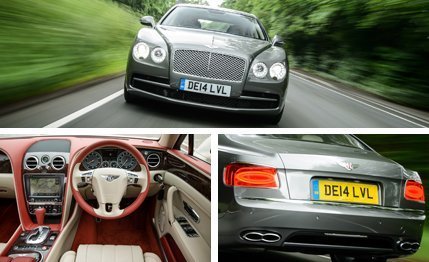
 First Drive Review
First Drive Review
Why would any potential buyer of a Bentley Flying Spur—a rolling symbol of a life lived large—ever choose an engine that has less power and fewer cylinders than the existing 6.0-liter W-12? We can pretty much discount price. The new V-8 model is $20,700 cheaper than the one powered by the W-12, and that would be considered a sizable discount in the real world. But as the V-8 still carries a base price of $197,825, it’s fair to assume that anyone who could afford it might easily stretch to the W-12. Specify a V-8 with the premium audio system, rear screens, and those all-important walnut picnic tables, and you’ve already offset the price difference between the two cars.
The eight-cylinder does give better gas mileage, in the unlikely event this matters any. It uses selective cylinder shutdown to turn itself into a V-4 under gentle use. But with the possible exception of Scrooge McDuck, it’s doubtful this will be a concern to many modern millionaires. It’s true that in some parts of the world the V-8 engine’s smaller displacement and more modest carbon-dioxide emissions will save buyers tens of thousands a year in taxes. But since the U.S. hasn’t succumbed to the forces of eco-Marxism quite yet, this difference can also be discounted.
No, the reason to choose the less powerful eight-cylinder is simple: It makes the Flying Spur a better car. We’ve already driven this engine in the Bentley Continental and Audi RS7, among others, and a refresher course behind the wheel of the Bentley gives a welcome reminder of just how good it is. The Spur V-8 can’t match the headline-grabbing performance figures of its bigger sister (it still manages 183 mph and an estimated 4.2-second 0-to-60 time), but the smaller engine’s keener throttle response and lag-free delivery more than offset its relative lack of power and torque.


It sounds better, too. The W-12 has an interesting noise—an overly busy exhaust note and induction roar often making it sound as if at least two engines were puffing beneath its bonnet. Yet the V-8 sounds like a V-8 should, a subdued purr under gentle use that turns into a pleasingly baritone snarl as the revs ascend.
Under and over Queen Victoria
Dynamic differences are relatively modest. The V-8 car is about 330 pounds lighter than the one with the W-12, with most of that mass coming off the front end. As a result, it turns slightly more willingly and steers with more precision. This hasn’t transformed the car, which still feels substantial in a premium luxury way. The ride quality is Bentley plush, deeply appreciated over some of the broken British back roads on which we drove the car. The air suspension offers four levels of damping, with even the softest keeping the body under tight control when asked to deal with asphalt that seemed to have been relaid for the last time under (or possibly over) Queen Victoria.


As with the rest of the Continental clan, the V-8 Spur’s four-wheel-drive system has been set up to ensure maximum traction at all times, and there’s never any sense that you can do much to influence your cornering line via the throttle. Not that you should try to, of course—you might spill the rear-seat occupants’ champagne. The eight-speed autobox shuffles its ratios smoothly and seamlessly in everyday use, but requests for sudden acceleration seem to confuse it momentarily as it delivers multiple kickdowns, one after the other. You can sharpen it by sliding the gear selector into Sport mode or taking control of selection yourself via the paddles located behind the steering wheel.
U.S. buyers have already been able to choose the V-8 engine in the Continental coupe and convertible, and a take rate nearing 50 percent proves it possesses an appeal beyond its modest cost saving. The Flying Spur V-8 confirms that, when it comes to Bentleys, less really can be more.